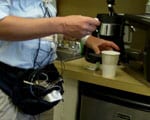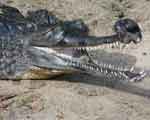The New York Times has written a comprehensive piece on the long-running global controversy surrounding double-amputee runner Oscar Pistorius, the South African vying to compete in the Olympics.
The Jan. 18 article, “The Fast Life of Oscar Pistorius,” cites extensively the work of SMU’s Peter Weyand, an expert in human locomotion. Controversy has swirled around Pistorius as the debate continues over the scientific advantage he enjoys as a result of his high-tech, carbon fiber artificial legs. Weyand helped lead a team of scientists who are experts in biomechanics and physiology in conducting experiments on Pistorius and the mechanics of his racing ability.
Weyand is widely quoted in the press for his expertise on human speed. He is an SMU associate professor of applied physiology and biomechanics in the Annette Caldwell Simmons School of Education & Human Development.
EXCERPT:
By Michael Sokolove
The New York Times
Oscar Pistorius trains inside a converted garage at the home of his personal trainer, a former professional rugby player. Iron pull-up bars and a variety of ropes and pulleys are bolted to brick walls. Free weights are lined up on the floor, along with hammered-together wooden boxes that serve as platforms for step-ups and standing jumps. Some of the equipment is clamped to an exterior wall of the garage, opposite an uncovered patio; when it rains, athletes just carry on and get soaked. “It’s old-school,” Pistorius said as we drove up to the place early one morning. “Some of the guys who train here, they bang it so hard, they often get sick in the garden. Nobody judges them.” [ … ][ … ] Since the initial paper was published, Weyand has been vocal in stating that Pistorius is at an advantage, a substantial one. The reasons he puts forward were not part of the rationale behind the I.A.A.F.’s disqualification of Pistorius — in effect, not among the “charges” against him — so Pistorius’s legal and scientific team did not have to disprove them at his appeal. The basis of the argument made by Weyand is not hard to follow: The Cheetah blade and its hardware are light, about 5.4 pounds as opposed to the weight of an intact leg and foot for someone of Pistorius’s build, about 12.6 pounds. As a result, his “swing times” — how quickly he can reposition his limbs — are unnaturally fast, “quite literally off the biological charts,” as Weyand (who did not testify in Lausanne) put it in a point-counterpoint debate with Herr in The Journal of Applied Physiology.
Weyand and a colleague, Matthew Bundle of the University of Montana (one of the seven authors listed on the initial journal article), expanded on this last year. “Mr. Pistorius can reposition his lightweight, artificial limbs in 0.28 seconds, and therefore 20 percent more rapidly than most intact-limb athletes,” they wrote. “To appreciate just how artificial Mr. Pistorius’s swing time is, consider that the average limb-repositioning time of five former 100-meter world-record holders (Ben Johnson, Carl Lewis, Maurice Greene, Tim Montgomery and Justin Gatlin) is 0.34 seconds. Mr. Pistorius’s limb-repositioning times are 15.7 percent more brief than five of the fastest male sprinters in recorded human history.”
The most provocative aspect of Weyand and Bundle’s argument — and clearly the biggest affront to Pistorius — is their calculation that the Cheetah blades, over the length of 400 meters, or once around the track, give him an 11.9-second advantage. That would make him no better than an average high school runner. Herr has dismissed this as a “back of the envelope” calculation, and in his contribution to the point-counterpoint, signed by four other authors of the initial paper, asked: “Would Weyand and Bundle predict that the world-record holder, Michael Johnson, would run 31s if he had both legs amputated?” [ … ]
SMU is a nationally ranked private university in Dallas founded 100 years ago. Today, SMU enrolls nearly 11,000 students who benefit from the academic opportunities and international reach of seven degree-granting schools. For more information see www.smu.edu.
SMU has an uplink facility located on campus for live TV, radio, or online interviews. To speak with an SMU expert or book an SMU guest in the studio, call SMU News & Communications at 214-768-7650.


 Public health insurance provides insured infants better, less costly care than private plans
Public health insurance provides insured infants better, less costly care than private plans A mathematical model determines which nations are more stable and which are more likely to break up
A mathematical model determines which nations are more stable and which are more likely to break up Indian, Vietnamese immigrants become American over time through civic activities, say anthropologists
Indian, Vietnamese immigrants become American over time through civic activities, say anthropologists


